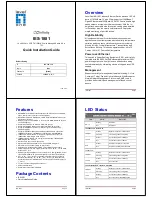
Functional Safety HiC284*
Operation
20
20
-0
7
17
5.2
Proof Test Procedure
Equipment required:
•
Digital multimeter with an accuracy of 0.1 %
Use for the proof test of the intrinsic safety side of the device a special digital multimeter
for intrinsically safe circuits.
If intrinsically safe circuits are operated with non-intrinsically safe circuits,
they must no longer be used as intrinsically safe circuits.
•
Power supply set to nominal voltage of 24 V DC
•
Simulate the sensor state by a potentiometer of 4.7 k
(threshold for normal operation),
by a resistor of 220
(short circuit detection) and by a resistor of 150 k
(lead breakage
detection).
Proof Test Procedure
1.
Put out of service the entire safety loop. Protect the application by means of other measures.
2.
Prepare a test set-up, see figures below.
3.
Simulate the sensor state by connecting a potentiometer, a resistor for short circuit detection
or by a resistor for lead breakage detection.
Test each input channel individually.
4.
Connect a potentiometer of 4.7 k
(threshold for normal operation) to the input.
The threshold must be between 1.4 mA and 1.9 mA, the hysteresis must be between
170
µ
A and 250
µ
A.
- If the input current is above the threshold the output must be activated for normal mode
of operation. The yellow LED lights up.
- If the input current is below the threshold the output must be activated for inverted mode
of operation. The yellow LED lights up.
5.
Connect a resistor R
SC
(220
) or a resistor R
LB
(150 k
) to the input.
The device must detect an external fault. This state is indicated by red LED and the output
of the corresponding channel must be de-activated.
6.
Test both outputs with a specific current, e. g. 10 mA. To avoid electric shock, use a test voltage
of 24 V DC. Check that the outputs contacts are not conducting.
The outputs must be de-activated. The outputs must
definitely not conducting
,
if the yellow LED is off.
7.
Set back the device to the original settings for the current application after the test.
8.
Check the correct behavior of the safety loop. Is the configuration correct?
9.
Secure the DIP switches to prevent unintentional adjustments.






































